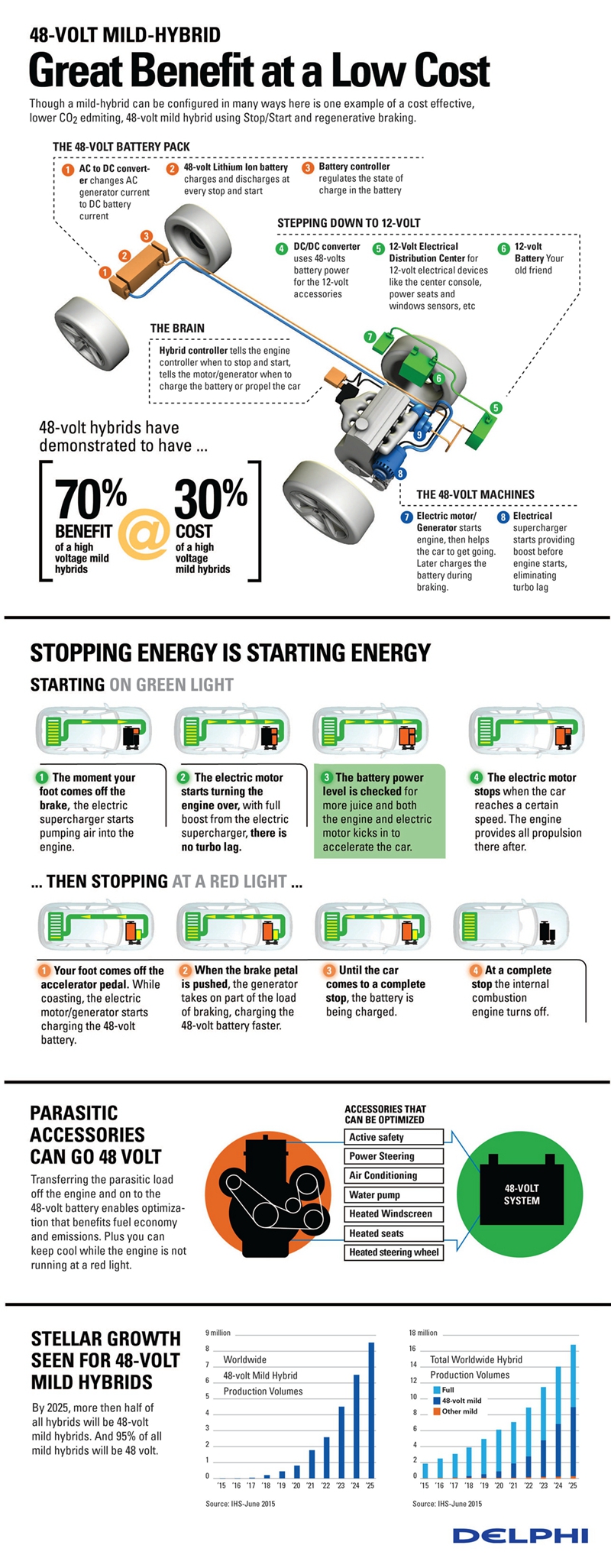
经德尔福测算,48V轻混系统能够以30%的成本达成纯电动汽车二氧化碳减排目标的70%。
德尔福认为48V轻型混合动力系统可以显著降低二氧化碳的排放量,造福未来的汽车行业。在2015年法兰克福车展上,德尔福全球先进电气与电子架构总监Christian Schäfer告诉《汽车工程杂志》,现在的许多技术驱动力都是在最近15年出现的。
“最主要的动力来自欧盟的规定,欧盟各国必须在2021年前让平均车队二氧化碳排放量降至95 g/km,”他表示。“我们的想法是,既然我们已经有一种轻混系统,那么就不必在所有车辆上安装高压电机了,因为这种方案造价太高。我们可以在较低的车型级别里使用48V系统,甚至是C级车。如果车辆没有后驱装置,那么我们可以用一种皮带驱动的启动器/交流发电机作为电机增压设备,也就是说,用交流发电机来提高内燃机的功率。”
德尔福认为,汽车启动后的最初100 米(328英尺)内可以用电力驱动。
Schäfer强调,再生制动技术将成为降低二氧化碳排放的主要方式。
“从我们的经验以及和欧洲各OEM的讨论结果来看,目前标称功率在10-12 kW之间的测试车队在搭载了48V交流发电机之后,二氧化碳排放量下降了7-10%。下一代驱动系统的输出功率将上升至20 kW,我们预测二氧化碳可以减少15%。”
德尔福认为,除了可以降低二氧化碳排放之外,将低压转换成高压还有别的好处。某些系统(如动态底盘控制)带来的车辆功率负载更高。“电流峰值将会很高,因此不能使用12V系统,” Schäfer表示。
此外,Schäfer表示,许多OEM的目标是取消发动机中的所有皮带驱动附件,但交流发电机除外。这意味着HVAC压缩器、动力转向泵和冷却剂泵等系统都将由这个48V系统来驱动。

48V系统可将皮带驱动的附件精简至一台启动器/交流发电机,并为自动驾驶汽车提供失效保护系统的供电。
“有皮带,就意味着将会产生很多摩擦,比如在高速公路上,动力转向泵是处于最高速度的,但其实并不需要这么高,” Schäfer表示。因此可以将动力转向泵做成一种“按需提供速度的”电力驱动系统。“这是另一种可以降低少量CO2排放的方法。”
对那些无法满足2021年欧盟CO2排放标准的汽车制造商而言,在安装了一个48V系统后,至少可以将排放水平降至处罚线之下。德尔福在和多家OEM的讨论中发现,20-70%的混合动力车都将配置一个48V的轻型混合动力系统。德尔福认为,纯电动汽车的销量增长情况并没有达到2009年和2010年时人们做出的预期,这种情况就是其原因之一。“你现在可以用30%左右的成本实现60-70%的目标,” Schäfer说。
现在德尔福正在研发48V系统所需的电气部件,其中包括一个3kW的DC/DC48-12 V转换器。
“最重要的是,这是一个双向装置。交流发电机所在的48V端在产生了3kW的功率后,将其传向12V端,为电池、乘员舒适性功能、照明系统和传统设备等供电,” Schäfer解释道,“但是为了让一辆12V的车升至48V,我们也配备了一个增压模式,将1kW标称功率从12V转换至48V。” 德尔福的这一设备将推出气冷和液冷两种选项。
该设施的其他部件还包括符合最高防水标准与抗震标准的48V 电气连接器。此外,德尔福还计划为48V系统设计一个警示色码,用以提醒用户这不是一个12V系统。目前认为48V应该标成蓝色。
德尔福预计在2016年开始生产48V电气分配器,输出电流为40安培。另外公司还在研发一款采用一种名为MOSFET的半导体熔线的智能48V分配器,预计于2017年投产。
“智能熔断是能够检测48V电板和12V电板上所有故障模式的唯一方法,” Schäfer称。它采用的原理是电弧检测,因为传统电气熔断丝太危险了。
德尔福使用一种算法来检测电弧。“我们必须区分‘好的电弧’和‘坏的电弧’”,Schäfer说,“好的电弧是继电器电弧。如果继电器处于断开状态,那么会电弧将一直保持着2毫秒。如果时间超过10毫秒,那我们就会关闭开关,但只关掉特定线路而非整个48V分配器。”
12-48V变电系统也会为未来的自动驾驶系统提供一定程度的电力冗余,以便配备失效保护系统。
作者:John Kendall
来源:SAE《汽车工程杂志》
翻译:SAE 上海办公室
Delphi says 48-volt mild-hybrid systems could offer 15% CO2 reductions

48-volt mild hybrids could offer 70% of the CO2 reduction benefits of battery electric vehicles at 30% of the cost, reckons Delphi.
Delphi believes that 48-volt mild hybrids could offer significant CO2 reductions and driver benefits for cars in the future. Speaking at the IAA 2015 (Frankfurt Motor Show), Christian Schäfer, Global Director of Advanced Electrical and Electronic Architectures at Delphi, told Automotive Engineering that there are several drivers for the technology that were not present 15 years ago.
“The main driver is the carbon dioxide threshold of 95 g/km fleet average in 2021 across the European Union," he said. "The idea is that we have a mild hybrid, so we don’t need high-voltage on all cars because it is too expensive to implement. We would have 48-volts, especially in the low segment, up to C-segment cars. Then we could have a belt-driven starter/alternator and can use it as an e-boost if you don’t have a rear drive unit, so the alternator is an electrical machine to boost the combustion engine.”
Delphi envisages that the car would start with electric propulsion for the first 100 m (328 ft) of movement.
Regenerative braking would be the main path to reduce CO2 emissions, reckons Schäfer.
“From our experience and our discussions with European OEMs, we have seen between 7 and 10 percent reductions in CO2 emissions from the current test fleet with today’s 48-volt alternators, which have a nominal power of between 10 and 12 kW. For the next generation with up to 20 kW, we expect that we could increase the CO2 reduction to 15%.”
Besides the CO2 reduction potential of 48-volt systems, Delphi sees other reasons to switch to the higher voltage electrical architecture. Some systems, such as dynamic chassis control, would impose a high power load on the car. “You would have high current peaks, so you can’t do it with a 12-volt system,” said Schäfer.
In addition, the aim of many vehicle OEMs, according to Schäfer, is to remove all belt-driven ancillaries from the engine with the exception of the alternator. This would mean that all these systems—such as the HVAC compressor, power steering pump, and coolant pump—would be driven electrically from the 48-volt system.

A 48-volt system could reduce belt-driven ancillaries to the starter/alternator and offer a fail-safe electrical architecture for autonomous driving.
“With the belt, you have a lot of friction; for instance on the highway, you have the highest speed on the power steering pump, but you don’t need it,” said Schäfer. Then power steering could be an “on-demand” electrically driven system. “That’s another way you can reduce CO2 emissions by a small amount.”
The penalty charges that would be imposed on manufacturers who might struggle to comply with the 2021 EU CO2 emissions average could at least be offset by fitting a 48-volt system. From the discussions that Delphi has already had, between 20 and 70 percent of all hybrids will be produced with a 48-volt mild-hybrid system. The company thinks that it is a reason why the growth in battery-electric vehicles is not as strong as was expected in 2009 and 2010. “You can reach about 60 to 70 percent of the targets with around 30 percent of the cost,” said Schäfer.
Delphi is already working on the electrical components that would be required for a 48-volt architecture. This includes a 3-kW DC/DC 48/12-volt converter.
“The important thing is that it is a bi-directional device, producing 3 kW from 48 volts where the alternator is, to the 12-volt side to support the battery and all the comfort functions, bulbs, and traditional equipment,” explained Schäfer, “But to make a jump start possible from a 12-volt car to a 48-volt car, we have a boost mode as well to transform 1 kW nominal power from 12- to 48-volts.” Delphi will produce the device with both air and liquid cooling options.
Other components include waterproof 48-volt electrical connectors that meet the highest waterproof and vibration-resistant standards. Delphi also plans to introduce color-coding for 48-volt systems to warn users that this is not a 12-volt system. The suggestion is that 48-volt systems should be coded blue.
Delphi expects to begin production of a 48-volt electrical distributor in 2016 that will provide a 40-amp output. A smart 48-volt distributor, incorporating a semi-conductor MOSFET fuse, is already in development, with production planned for 2017.
“Smart fusing is the only chance to detect all failure modes which could occur on a 48-volt and 12-volt board,” said Schäfer. This would include electrical arc detection, because it could be too dangerous to use conventional electrical melting fuses.
An algorithm is used to detect arcing. “We have to distinguish [between] 'good arcs' and 'bad arcs,'” said Schäfer, “The good arcs are the relays. If a relay is open, there is always an arc for around 2 ms. If we have more than 10 ms, we would switch off and then only the dedicated path and not the complete 48-volt system.”
A 48-volt architecture in combination with 12-volt system also offers a level of electrical redundancy for future autonomous driving systems, where a failsafe system would be required.
Author: John Kendall
Source: SAE Automotive Engineering Magazine
等级
打分
- 2分
- 4分
- 6分
- 8分
- 10分
平均分
